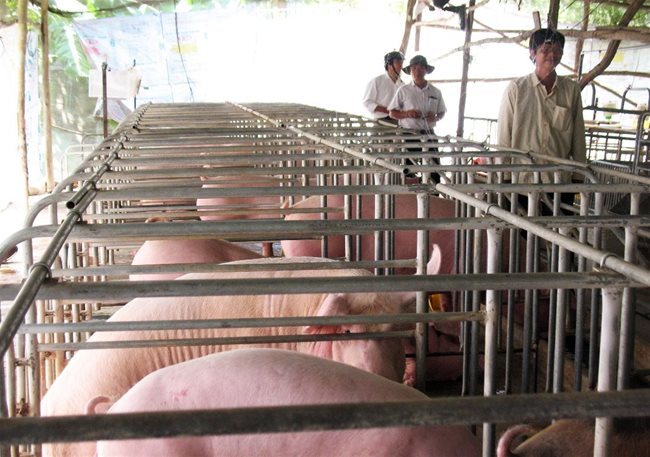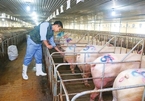 |
| A pig farm in the Mekong Delta. Despite the strong price rise, small pig farmers are still prudent. They have not yet repopulated their pig herds due to big losses suffered in 2019 when their pigs had to be culled, and are wary of a possible return of the ASF outbreak any time - PHOTO: LE HOANG VU |
The African swine fever (ASF) which broke out in early 2019 has reduced drastically the pig herds, sending prices of pork soaring since the second half of last year.
In the basket of commodities for calculation of the consumer price index (CPI) in end-June 2020, food and foodstuff prices posted the strongest price rise, at 12% against the same period last year, due mainly to pork.
Despite the strong price rise, small pig farmers are still prudent. They have not yet repopulated their pig herds due to big losses suffered in 2019 when their pigs had to be culled, and are wary of a possible return of the ASF outbreak any time. Normally, it takes between six and seven months to release a brood of pigs as this is the period they have the highest rate of lean meat.
It is estimated that 60% of Vietnam’s pork market is held by farmers and 40% by big businesses like CP Vietnam, Mavin, Dabaco and CJ. Pork supply by farmers is falling drastically due to diseases, while big firms are not much affected because they have applied technology and a closed rearing system.
To replenish pork supply from farmers, it needs time as well as the Government supports for pig repopulation, such as credits, farming technology, and methods and measures to prevent the recurrence of diseases. The pace of repopulation depends on the supports and the disease situation. Meanwhile, enterprises still maintain an increase in supply because they can take initiative in breeding pigs and feed and apply the closed rearing system.
Handsome profit
Animal husbandry enterprises have achieved excellent business results in the two most recent quarters since the ASF outbreak which has sent pork prices soaring. The average sales of six listed enterprises with pork trading activities in Q4 2019 increased 7% and their profits surged 77%. In Q1 2020, the results were even more positive, with the average sales rising 26% and profits skyrocketing over 400%. The figures show that though animal husbandry enterprises do not post strong sales growth, their business results, manifested by profit, have improved considerably thanks to an increase in pork prices versus a much slower rise in pig care and farming costs.
A typical example is Dabaco (DBC). The company owns eight pig farming centers in the North with a designed productivity of 750,000 breeding pigs per year. Products from farmed pigs have made up a large share of Dabaco’s revenue over the past many years. Its profit in Q4 2019 increased 127.2%, but shot to 1,638.7% in Q1 2020. The revenue in Q 2 2020 is estimated at over VND3.1 trillion but after-tax profit could reach nearly VND400 billion, 50 times higher than the figure in the same period last year, sending the cumulative profit in the first half of this year to over VND740 billion, the highest ever in the company’s business history. In view of the profit target of VND457 billion for the entire 2020 approved by Dabaco’s shareholders in April, the company has achieved over 160% against the target.
The rise in pork prices has helped increase sales and profit of Hoa Phat Steel Company (HPG), which operates mainly in steel business, in the first half of this year. In Q1, the company gained a profit of over VND480 billion from its agro-trading arm, and the profit in Q2 is estimated to be the same, accounting for 10-12% of its total profit.
The animal husbandry company Mitraco (MLS) achieved a gross profit of VND93 billion in Q1 2020, up 34% year-on-year, and an after-tax profit of overVND22 billion. The company could achieve the whole year profit target of VND40 billion by end-June, while it suffered a loss of VND11 billion last year. It has two high-quality breeding pig centers in Ha Tinh Province.
Vissan (VSN) currently owns the most modern and largest animal slaughtering system in Vietnam, with five slaughtering lines at three factories capable of slaughtering 109,500 cows and 876,000 pigs and processing 28,000 tons of foods a year. The company has joined price stabilization programs with prices 5-10% lower than market prices to support consumers as instructed by the Government. Therefore, its business growth is lower than the average growth of the industry as well as many listed enterprises.
Overall, many animal husbandry enterprises are leveraging the shortage in pork supply to sell at high prices, earning huge profit. The question is how long the high prices will stay in the face of the Government’s strong efforts for price stabilization? Further, if the high prices persist for a long time, it may encourage many enterprises to expand their pig herds and many farmers to repopulate their herds. The increase in pig supply may send prices down. Therefore, investors seem to see the strong improvement in business results of animal husbandry enterprises as a short story, and lock in profit while their share prices are rising high. Take as example, VinaCapital and SSI have continuously sold DBC shares they held in recent times when prices have soared nearly 300%. SGT

Sky-high livestock prices may breach competition law
Although many livestock companies could face an inspection to ensure they follow through on commitments to cut their prices, the market outlook still looks dreary in spite of the government’s call to stabilise the selling cost of live pigs.

Vietnamese billionaires pour money into non-core business fields
While billionaires have been expanding their business fields, other businesspeople have scaled down their operations and sold some subsidiaries.